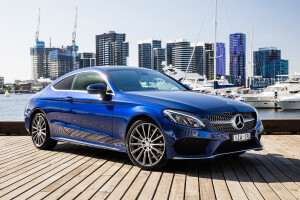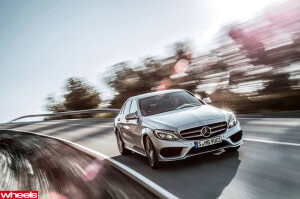Latest Review

First drive: 2022 Mercedes-Benz C-Class
Touches of E- and S-Class trickle down to the new C-Class... but does it live up to Mercedes' hype?
Insipid on the outside it may be, but the interior of the new Mercedes-Benz C-Class is intense. It's an elegant, beautifully crafted blend of tradition and technology that is profoundly impressive and instantly attractive. Yes, it really is a lot like an S-Class in here...
The effect is especially strong in this light-coloured cabin of this C300 sedan, one of the fleet of new C-Classes Mercedes-Benz has brought to Immendingen for introductory test drives by media able to travel into Germany. The lower section of the car's instrument panel is dark wood strips divided by thin metal inlays, a combination that's one of the best-looking in the new S-Class.
Like the other C-Class variants available to drive on Mercedes-Benz's massive new proving ground south of Stuttgart and public roads around it, this C300 is heavily optioned. It has bigger central and driver display screens, every driver-assistance system available, top-level LED matrix headlights and rear-wheel steering.
Longer, lower and a little wider than before, the fifth-generation W206 is slightly more roomy than the W205 C-Class it replaces. With a wheelbase 25mm longer than before, the difference is most noticeable in the rear seat. There's more knee room than before, and greater head room. Large adults will find the too-short cushion is about the only thing worth complaining about.
From the driver's seat, the big screens and scarcity of physical buttons present a pleasing panorama. The new steering wheel, too, is attractive. This car doesn't have the thicker-rimmed AMG Line wheel with doubled horizontal spokes. The slimmer rim is nicer to hold and the touch controls on its spokes are more natural to use.
Having earlier tried the C200, there's pressure on the C300. Performance of the turbo 1.5-litre of the lesser model isn't awful, but the four-cylinder lacks refinement. It's gruff in the 2000 to 3000rpm zone of its rev range, where the standard nine-speed auto keeps it operating for much of the time.
It's an elegant, beautifully crafted blend of tradition and technology that is profoundly impressive and instantly attractive.
The turbo 2.0-litre four of the C300 is a much sweeter engine. It's feistier, of course, but also sounds better. The C200 and C300 sedans will be the first of the new C-Class family to arrive in Australia, sometime in the fourth quarter of this year. It's clear, at least to me, which one is the smart choice.
Both engines are equipped with 48-volt mild hybrid technology. The system's motor is an integrated starter generator sandwiched between engine and auto, a more sophisticated way to do it than the bolt-on belt-drive hardware chosen by some other brands.
In operation the system is unobtrusive. Though able to add 15kW and 200Nm, the motor doesn't increase the engine's 190kW and 400Nm maximums by the same amounts. This is because the electric motor and the internal-combustion engine, which are harnessed together, peak at different points in the rev range. What the driver will notice is strong step-off acceleration and instant engine restarts when the Stop/Start system is at work, as well as impressive fuel efficiency.
Key changes to the new C-Class platform are quicker steering and a compact rear multilink suspension design that mimics the S-Class. On the optional-in-Europe adaptive suspension of the C300 tester, there's a truly S-Class feel to the way it rides in default Comfort mode.
Some may find the flotation-tank serenity soothing, but my personal preference is for a little more in the way of connection and control. Easily fixed; simply select Sport mode.
But this creates another problem. Like many other German cars, Sport mode alters transmission behaviour, restricting access to the higher gears and holding the gears it does select for too long.
Eventually I pull over and make Individual mode menu selections to get the C300 to drive the way I want; Sport for the suspension, Comfort for the steering and powertrain, in case you're interested. This combination really suits the calmly competent character of the new C-Class.
While the advantages of the optional rear-wheel steer system weren't blindingly apparent on the road, it does definitely improve the C-Class's handling stability. The special course set up on an Immendingen test track to demonstrate the tech was wet when I drove another C300 around it. The tenaciousness of rear-end grip through high-speed slaloms and swerve-and-recover manoeuvres was simply amazing.
While it doesn't much reduce the new C-Class's turning circle, rear-wheel steer is an option that keen drivers should consider. If it's priced reasonably.
It's not only option costs that are not known. Mercedes-Benz Australia is yet to announce prices of the C200 and C300, though there are hints that base prices and standard equipment levels will rise compared to the current C-Class.
This means the C300 is likely to creep close to the $80,000 barrier. While the exterior does little to make a case for buying the new C-Class, its interior is very, very persuasive.
2022 Mercedes-Benz C300 specifications
News
-
 Advice
AdviceAustralia's top romantic drives on Valentine's Day (or any day!)
Not just for Valentine’s Day: Here are a few Australian road trips to put in the diary for your next romantic getaway.
-
 Advice
AdviceDiesel vs Hybrid engines: which is the better petrol alternative?
Want to go longer between fuel stops? Diesel and hybrid powertrains both sip fuel, but which is better than the other?
-
 News
NewsMercedes-Benz will upgrade your C200 into a C300 for free
The limited time offer means Benz buyers can save $8000 off the price of a new C300 sedan
-
 Advice
AdviceWagon vs SUV – what’s better?
There are some pretty good reasons why the SUV has become the go-to car for modern Aussie families, but that doesn’t mean traditional wagons have been rendered obsolete – far from it.
-
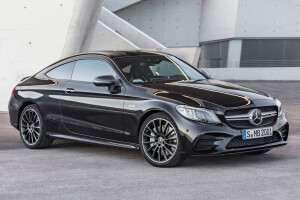
2019 Mercedes-Benz C-Class Coupe and Cabriolet gain mild hybrid tech
-

Mercedes-Benz C-Class Coupe and Cabrio updated
-
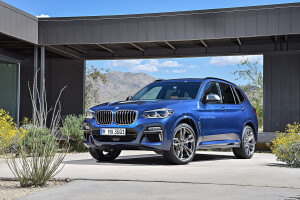
Incoming: New cars to look forward to this October and November
-
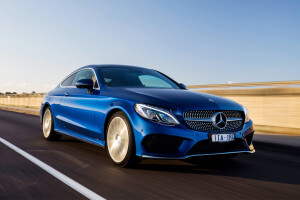
2017 Mercedes-Benz C-Class price and features announced




